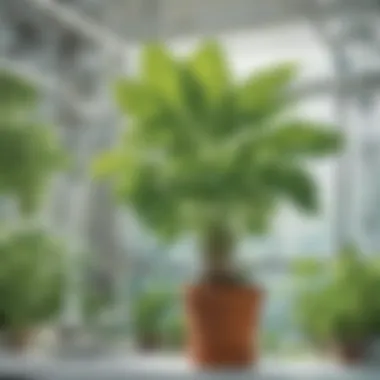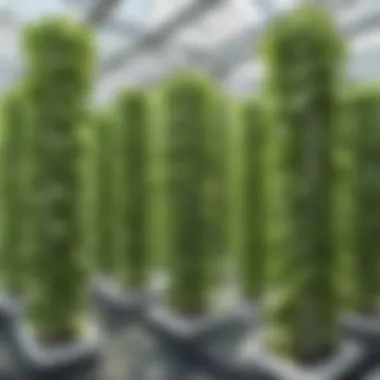Unlocking the Secrets of Hydroponics: A Comprehensive Guide for Aspiring Scientists


Science Fun Facts
Hydroponics, a method of growing plants without soil, has been used since ancient times. Ancient civilizations like the Babylonians and Aztecs practiced forms of hydroponics to cultivate their crops. The Hanging Gardens of Babylon are believed by some to have utilized hydroponic techniques to nurture their lush greenery in a soil-less environment. The Aztecs constructed floating gardens called chinampas, which employed hydroponic principles to grow a variety of crops efficiently.
Discover the Wonders of Science
Exploring the world of hydroponics unveils a plethora of scientific concepts. From understanding nutrient absorption to the physics of water circulation, hydroponics offers a hands-on approach to learning about plant biology and agricultural practices. Visualizing the roots of plants submerged in water, devoid of soil, leads to engaging discussions on how plants adapt and thrive in various environments.
Science Experiment Showcase
Engaging in hydroponic experiments provides a fun and interactive way for budding scientists to apply their knowledge. Setting up a basic hydroponic system using materials like a reservoir, net pots, growing medium, and a nutrient solution enables hands-on learning about plant growth dynamics. By following step-by-step instructions, children can observe firsthand how plants flourish in a controlled hydroponic environment, fostering a deeper appreciation for sustainable agriculture practices.
Science Quiz Time
Testing knowledge on hydroponics through interactive quizzes and brain teasers adds an element of gamification to the learning process. Multiple-choice questions about nutrient solutions, p H levels, and plant growth in hydroponic systems challenge young minds to think critically about the intricacies of soil-less farming. By incorporating gamified elements into the educational journey, children can enhance their understanding of hydroponics while enjoying a playful approach to scientific exploration.
Introduction to Hydroponics
Hydroponics, the practice of growing plants without soil, is a fascinating subject that offers a new perspective on traditional gardening methods. In this comprehensive guide for budding scientists, we will delve into the intricacies of hydroponic systems, exploring how they function and the benefits they provide. Understanding the basics of hydroponics is essential for anyone looking to venture into this innovative approach to plant cultivation.
What is Hydroponics?
In comparing traditional farming with hydroponics, significant differences emerge in terms of resource usage and efficiency. Traditional farming relies on soil as a medium for plant growth, whereas hydroponics utilizes water enriched with nutrients. This distinction is crucial as hydroponics offers higher yields in a controlled environment, proving to be a more sustainable and practical choice for modern agriculture endeavors. The versatility of hydroponic systems allows for precise control over nutrient delivery, leading to healthier plants and increased productivity.
Benefits of Hydroponic Gardening
Water Efficiency


Water efficiency is a key advantage of hydroponic gardening, where water is recycled within the system, minimizing wastage. Unlike traditional farming methods that often lead to water runoff and evaporation, hydroponics ensures that plants receive the precise amount of water needed for optimal growth. This sustainable approach not only conserves water but also reduces the overall environmental impact of agriculture.
Optimal Nutrient Absorption
Achieving optimal nutrient absorption is another significant benefit of hydroponic gardening. By directly delivering nutrients to plant roots in a water-based solution, hydroponic systems eliminate the need for plants to search for nutrients in the soil. This efficient nutrient uptake results in healthier plants with increased growth rates and higher nutrient content. Overall, hydroponic gardening proves to be a more efficient and effective method for plant cultivation, offering unparalleled control over nutrient levels and ensuring superior plant development.
Setting up Your Hydroponic System
Setting up your hydroponic system is a pivotal aspect discussed in this informative article. The process of establishing a hydroponic system involves meticulous planning and execution to ensure optimal plant growth. It plays a vital role in the success of your hydroponic garden by providing plants with the necessary environment to thrive. The proper setup of your system contributes to factors such as nutrient delivery, oxygenation, and stability for plant roots. By carefully selecting the right components and configuring them correctly, you lay the foundation for a productive and sustainable hydroponic setup.
Choosing the Right System
When it comes to choosing the right hydroponic system, various types are available, each offering distinct advantages and considerations. Understanding the differences between systems such as Deep Water Culture (DWC), Nutrient Film Technique (NFT), and Ebb and Flow is essential in determining which aligns best with your gardening goals. The choice of system significantly impacts factors like water usage, nutrient uptake, and maintenance requirements. Evaluating the space available, plant selection, and level of involvement can guide you towards selecting the most suitable system for your hydroponic venture.
Types of hydroponic systems
Types of hydroponic systems vary in design and operation, with each type catering to specific needs and preferences of growers. For instance, the DWC system is popular for its simplicity and effectiveness, providing a deep reservoir for plant roots to thrive. On the other hand, the NFT system offers continuous nutrient flow, promoting efficient nutrient absorption for plants. Considering the unique features of each system, such as ease of maintenance, scalability, and space utilization, helps in determining the optimal choice for your hydroponic garden.
Selecting Plants for Hydroponic Growth
Selecting plants suitable for hydroponic growth is a crucial decision that influences the success of your gardening endeavor. Herbs, leafy greens, and fruit-bearing plants are popular choices for hydroponic cultivation, offering a diverse range of options for growers. Each type of plant presents unique requirements in terms of nutrient intake, lighting, and space utilization. By carefully selecting plants that align with your preferences and growing conditions, you can enhance the productivity and sustainability of your hydroponic system.
Herbs
Herbs are commonly grown in hydroponic systems due to their compact size and rapid growth cycle. They thrive in nutrient-rich environments, allowing for robust foliage development and intense flavor profiles. The controlled environment of a hydroponic system offers herbs optimal conditions for growth, minimizing competition with weeds and soil-borne diseases. By selecting herbs like basil, mint, and cilantro for hydroponic cultivation, you can enjoy a fresh supply of aromatic herbs year-round.
Leafy greens
Leafy greens such as lettuce, kale, and spinach are ideal candidates for hydroponic cultivation due to their shallow root systems and high demand in culinary use. These plants benefit from direct nutrient delivery and consistent moisture levels, leading to rapid growth and vibrant foliage. By selecting nutrient-dense leafy greens for your hydroponic garden, you can create a sustainable source of fresh greens for salads and other culinary creations.


Fruit-bearing plants
Growing fruit-bearing plants like tomatoes, peppers, and strawberries hydroponically requires attention to their specific requirements for light, nutrients, and support. These plants exhibit longer growth cycles and higher nutrient demands compared to herbs and leafy greens. However, the controlled environment of a hydroponic system provides an opportunity to optimize growing conditions, resulting in healthy fruit development and continuous harvests. By selecting fruit-bearing plants suited to hydroponic growth, you can experience the joy of harvesting homegrown fruits throughout the year.
Essential Components for Hydroponic Growth
Hydroponics, a method of growing plants without soil, relies on several essential components to facilitate plant growth efficiently. In this comprehensive guide for budding scientists, understanding the critical elements of hydroponic systems is paramount. By delving into the world of hydroponics, individuals can explore the intricate details that govern plant cultivation.
Nutrient Solutions
Balanced pH levels
Balanced p H levels play a crucial role in hydroponic systems, ensuring optimal nutrient uptake for plant growth. Maintaining a balanced pH level is essential to prevent nutrient deficiencies or toxicities that can hinder a plant's development. In this article, we emphasize the significance of monitoring and adjusting pH levels to create a stable environment for plants to thrive. The unique feature of balanced pH levels lies in its ability to regulate nutrient absorption, promoting healthy plant growth while minimizing the risk of imbalances.
Key nutrients for plant growth
Key nutrients are fundamental for plant development in hydroponic setups. By providing essential elements such as nitrogen, phosphorus, and potassium, hydroponic gardeners can foster robust and vibrant plant growth. This article sheds light on the importance of these nutrients and their specific roles in supporting plant functions. Exploring the unique features of key nutrients offers a profound understanding of their contributions to plant health. By discussing the advantages and disadvantages of key nutrients in hydroponic growth, readers can grasp the nuanced interplay between plant nutrition and system effectiveness.
Lighting in Hydroponics
LED vs. HID lighting
The choice between LED and HID lighting systems is a critical consideration for hydroponic enthusiasts. LED lighting offers energy efficiency and customizable spectral output, making it an increasingly popular option in modern hydroponic setups. Alternatively, HID lighting provides robust light intensity suitable for various growth stages of plants, presenting a reliable alternative for traditional indoor gardening. This section of the article delves into the distinctive features of both lighting systems, outlining their advantages and disadvantages within the context of hydroponic gardening. By exploring the nuanced differences between LED and HID lighting, readers can make informed decisions to optimize plant growth and yield in their hydroponic systems.
Maintaining Your Hydroponic System
In the domain of hydroponics, maintaining your hydroponic system holds a pivotal role in ensuring the optimal growth and health of your plants. It involves a series of essential tasks and checks that contribute to the overall success of your hydroponic setup. By meticulously monitoring and regulating various aspects of your system, you can create an environment that fosters plant growth and development effectively. Proper maintenance ensures that your plants receive the necessary conditions to thrive, enhancing their yield and quality.
Monitoring p


H and EC Levels
Importance of pH balance
The p H balance of the nutrient solution in a hydroponic system is a critical factor that significantly impacts the absorption of essential nutrients by plants. Maintaining the correct pH level is vital as it directly influences the availability and uptake of nutrients, thus affecting the overall health and growth of plants. An optimal pH balance ensures that plants can access nutrients efficiently, leading to robust growth and vibrant foliage. Striking the right pH balance is imperative for maximizing the potential of hydroponic gardening and achieving optimal plant performance.
Electrical conductivity for nutrient levels
The electrical conductivity (EC) of a hydroponic solution serves as a measure of the concentration of nutrients present in the water. By monitoring the EC levels, growers can gauge the nutrient strength in the solution, allowing for adjustments to be made accordingly. Proper electrical conductivity management ensures that plants receive the appropriate nutrient levels, promoting healthy growth and development. Understanding and controlling EC levels aid in preventing nutrient deficiencies or imbalances, leading to improved plant vigor and productivity.
Managing Pests and Diseases
Natural pest control methods
The utilization of natural pest control methods in hydroponic systems is a strategic and eco-friendly approach to safeguarding plants from harmful pests and diseases. Implementing natural solutions such as beneficial insects, companion planting, and biological controls can effectively mitigate pest infestations without resorting to harmful chemicals. These methods work symbiotically with the hydroponic environment, creating a balanced ecosystem that deters pests while promoting plant health. By incorporating natural pest control measures, growers can protect their crops organically, ensuring a pesticide-free harvest and sustainable cultivation practices.
Tips for Successful Hydroponic Gardening
As we embark on the journey of hydroponic gardening, a crucial aspect worth delving into is optimizing growth conditions for our plants. To ensure their thriving and flourishing, it is imperative to pay meticulous attention to factors such as temperature and humidity control. These elements play a pivotal role in the overall success of our hydroponic endeavor, influencing the health and productivity of the plants we aim to cultivate. Understanding the significance of such conditions underscores the essence of our efforts in achieving maximum growth potential. By focusing on optimizing growth conditions, we set the stage for a fruitful and rewarding cultivation experience.
Optimizing Growth Conditions
Temperature and humidity control
When considering temperature and humidity control within the realm of hydroponics, we are faced with a foundational aspect that directly impacts plant growth and development. The regulation of temperature and humidity levels in the hydroponic environment is vital for ensuring the optimal conditions essential for plant vitality. By maintaining appropriate levels of heat and moisture, we create an environment conducive to robust growth, allowing plants to thrive and reach their full genetic potential. The controlled balance of temperature and humidity fosters an ideal atmosphere for plant cultivation, enhancing nutrient absorption and metabolic processes. This harmonious relationship between temperature and humidity forms the bedrock of successful hydroponic gardening, providing an environment that mirrors the plant's natural habitat within the controlled confines of our growing setup.
Consistent Maintenance Practices
Regular system checks
In the realm of hydroponic gardening, regular system checks emerge as a fundamental practice crucial for sustaining the health and performance of our cultivation setup. Through routine inspections and assessments, we proactively monitor the system's functionality, identifying any potential issues or irregularities that may impede plant growth. The diligent observation of system components, such as nutrient levels, water circulation, and equipment integrity, ensures the continued efficiency of our hydroponic system. Regular system checks enable us to preemptively address any deficiencies or malfunctions, ultimately safeguarding the well-being of our plants and preserving the productivity of our garden. By incorporating this maintenance routine into our hydroponic regime, we establish a proactive approach to cultivation management, promoting longevity and success within our growing environment.
Cleaning and sanitation
Another critical facet of maintaining a healthy hydroponic system is the practice of cleaning and sanitation. This essential task involves the thorough cleansing and disinfection of system components to prevent the buildup of harmful pathogens and contaminants. By implementing a strict cleaning regimen, we mitigate the risk of diseases and infestations that can jeopardize plant health and overall crop yield. The meticulous attention to sanitization not only promotes a hygienic growing environment but also enhances the efficiency and longevity of our hydroponic system. Embracing regular cleaning and sanitation practices exemplifies our commitment to cultivating plants in a clean, disease-free setting, fostering optimal growth conditions and ensuring the success of our hydroponic journey.







